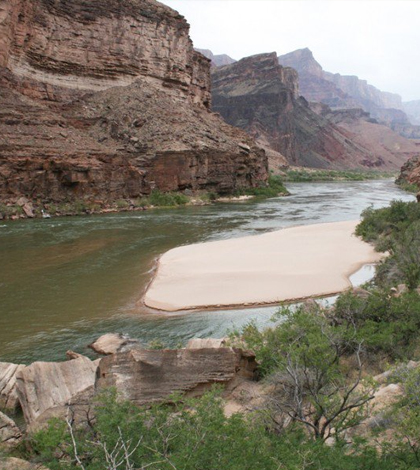Western Drought May Threaten Replenishment Of Colorado River Sandbars

A sandbar deposited by a controlled flood in the Grand Canyon section of the Colorado River. (Credit: Matt Kaplinski, Northern Arizona University)
The success of controlled flooding techniques used to replenish the Colorado River’s ecologically valuable sandbars between the dam on Lake Powell and Lake Mead is encouraging to scientists studying their effectiveness, according to a research summary published in Eos. But it is difficult to predict how successful the controlled floods will be in the future, they write, especially considering the water woes hitting large portions of the West.
Researchers with many organizations help to study the controlled floods, as well as the river overall. The list includes the Department of Interior, U.S. Geological Survey, University of California and many others. The scientists use techniques like photographic analysis and topographic surveys to study the short- and long-term effects of controlled flooding on the river’s sandbars.
“A network of remote time-lapse cameras at 43 sites distributed throughout Grand Canyon captures daily changes in sandbars that show the immediate effects of each controlled flood,” researchers write in the Eos summary.
More sophisticated tech is employed as well.
“To time controlled floods for maximum sandbar-building effect, U.S. Geological Survey scientists continuously monitor sand flux at the downstream end of Marble Canyon using acoustic instruments calibrated to conventional sampling of suspended sediment,” researchers write. “Scientists also make initial estimates of sand inputs from Paria River (a tributary) floods within 24 hours of each event using a model based on observed correlations among discharge, sand concentration, and sand grain size.”
Using those and other types of equipment and methods, researchers have gauged the success of controlled floods in the Grand Canyon since 1996. They made useful findings from the very first controlled release.
“The first controlled flood occurred in 1996. This release demonstrated that sandbars grow rapidly during the first few days of a flood and that much of the deposition is eroded within 6 to 12 months by normal dam operations,” researchers write. The most important finding from that flood was that the sand supplied to the river had a short residence time. “These findings revealed the importance of timing controlled floods to occur shortly after flash floods from major tributaries (that) deliver sand to the Colorado River.”
Up until the current period of drought in California and other parts of the West, the use of controlled floods to replenish the river’s sandbars was a reliable method, scientists say. But that past is not a good indicator of how successful the method could be in the future, given the long-term dryness that has plagued the region for years.
“The success of these initial controlled floods does not guarantee that sandbars will continue to grow. Sandbars erode between each controlled flood. Thus, the long-term effects of the HFE (high-flow experiment) protocol depend on how Colorado River runoff, operational decisions about releases from Lake Powell, and seasonal precipitation in the Paria River and other tributary watersheds affect the ability of dam operators to continue implementing controlled floods,” scientists write. “Future sediment inflows from tributaries are highly uncertain because they depend heavily on flash floods triggered by rainfall associated with intense seasonal thunderstorms, which deliver a large fraction of the Southwest’s rain.”
Top image: A sandbar deposited by a controlled flood in the Grand Canyon section of the Colorado River. (Credit: Matt Kaplinski, Northern Arizona University)




0 comments